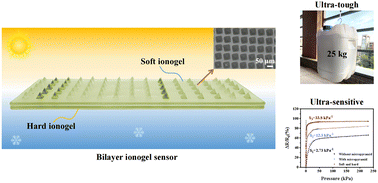An ultra-tough and ultra-sensitive ionogel pressure/temperature sensor enabled by hierarchical design of both materials and devices†
Abstract
Flexible sensors based on ionogels show great potential in wearable devices because of their compliance and deformability. However, ionogel sensors usually suffer from low mechanical properties and poor sensitivity. Herein, we report a supramolecular ionogel with combined hierarchical dynamic bonds (hydrogen bonds, Zn(II)–carboxylate coordination bonds and Zn–(Al-Hbimcp) (Al-Hbimcp = 2,6-bis((E)-(allylimino)methyl)-4-chlorophenol) coordination bonds) as crosslinking points. The obtained ionogels possess superior mechanical robustness (fracture strength of 21 MPa, Young's modulus of 325 MPa, fracture strain of 1120%, toughness of 102 MJ m−3, fracture energy of 87.7 kJ m−2 and puncture energy of 4570.8 mJ), high ionic conductivity, broad environmental tolerance and self-healing properties. Moreover, inspired by the microstructure and gradient distribution of the finger, we fabricated a soft and hard hybrid bilayer ionogel pressure/temperature sensor with a micro-pyramid structure. The sensor exhibits extraordinary pressure (33.8 kPa−1) and temperature sensitivity (3.79 °C−1), enabling the monitoring function of human heartbeat and breathing. Hence, the designed ionogel sensor has great application prospects in multifunctional flexible wearable devices.



 Please wait while we load your content...
Please wait while we load your content...